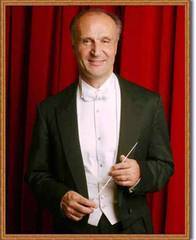|
Back
Behold the Mysteries New York
Jazz at Lincoln Center’s Rose Theater, Frederick P. Rose Hall
05/05/2017 -
Arnold Schoenberg: Chamber Symphony No. 1, Opus 9
Franz Schubert: Symphony No. 3, D. 200
Dmitri Shostakovich: Symphony No. 15, Opus 141
The Orchestra Now (TON), Oleg Caetani (Conductor)

O. Caetani (© Courtesy of the Artist)
“I don’t understand his music. But he is young and I am old, and maybe he is right.”
Gustav Mahler, at premiere of Arnold Schoenberg’s Chamber Symphony
Neither the composer nor the work are exactly young (31 and 107 years respectively) but the players were certainly young, and certainly seemed to understand this piece. The members of Leon Botstein’s “The Orchestra Now” (TON), pre-professionals, artists taking their Master’s Degree from Bard College. They are international (a dozen different countries) and enthusiastic., And while TON has been in existence just two years, they surveyed last night two extremely difficult pieces from the 20th Century and made a good go of it.BR />
The Schoenberg is still puzzling to some, but it was made easier by a musical introduction from the clarinetist of the group, Micah Candiotti-Pacheco. Playing the different scales of the work–whole-tone and an awkward chromatic–with Schoenberg’s quatral motives (in fourths), he gave a simple but cogent explanation.
Which was hardly needed by those who have ears. First, the Chamber Symphony was not played in the later full-orchestra version, which can be muddy and thick. This was as transparent as a work by Brahms, which it resembled (almost quoted at times) rather than Mahler. Secondly these First Chair players of TON didn’t have to worry about virtuosity per se. They are first-rate artists in their own right, and hearing them play solo was a joy of clarity.
Which was helped by a most regal conductor, Oleg Caetani, a man with an obvious rapport with this group.
The result was not a forced or flowery piece of post-Romanticism (which it almost resembles), but a work of supreme energy. Mr. Caetani started that tight introduction and the rising fourths–a motif as revolutionary in its way as the bassoon opening in Sacre. After this, we had a work which whipped through the different movements with a maximum of color and volition.
More surprising, never having studied the score, by listening to it live, one feels this double standard: partly breaking the bonds of 19th Century music, but just as frequently returning to regular cadential harmonies. Mr. Caetani understood this, and never let the players surrender to the notes. This was not music of expressionism, but of expression, and extremely impressive.
Far more impressive than the opening Schubert Third Symphony. Perhaps the rehearsals had concentrated more on the challenging Schoenberg and Shostakovich, for this Schubert, which should float and dance (he didn’t have a slow movement in this work written for a Vienna school orchestra) resembled yesterday’s New York weather yesterday. Soggy and heavy.
Nothing was wrong with the players. But they played by rote, and Mr. Caetani simply couldn’t raise them to the simply exhilaration which the 18-year-old composer needed.
Since age is mentioned twice, one must now present the most utterly gorgeous, scintillating and, yes, grandiose work of the evening. One of the final works by the ailing 65-year-old Dmitri Shostakovich, the 15th Symphony, which–far more than the popular Fifth or the storybook “Leningrad” or “October” symphonies–reveals the conscious/subconscious mind of this great composer.
A work which begins and ends with Toy Story (where toys come alive after the store closes) and contains medieval chorales, plaintive solos (Eleanor Lee’s long cello solo and Lili Sarayra’s violin solos were rich and lovely), and quotes from Rossini and Wagner.
This was where the entire TON Ensemble came together under Maestro Caetani for a pretty gripping performance. No, TON wasn’t able to produce the sardonic humor, the edgy wit, but that wasn’t needed. Instead, it was full-breathing massive performance for which Mr. Caetani appropriately thanked each consort and each soloist individually.
Cellist Alexis Shannon’s program notes end saying that Shostakovich’s “intention with his quotations will have to remain a mystery.”
As the whole symphony is a mystery. As every worthy piece of music will always have the mystery of creation behind it. May they, and their myriad performers, including TON, be blessed for their efforts.
Harry Rolnck
|